人教版新目标七年级上册unit1.Period twoMy name’s Gina(共16张PPT)
人教版新目标七年级英语上册Unit1My name’s Gina知识点单词过关单元语法聚焦及课时练习分层训练附答案
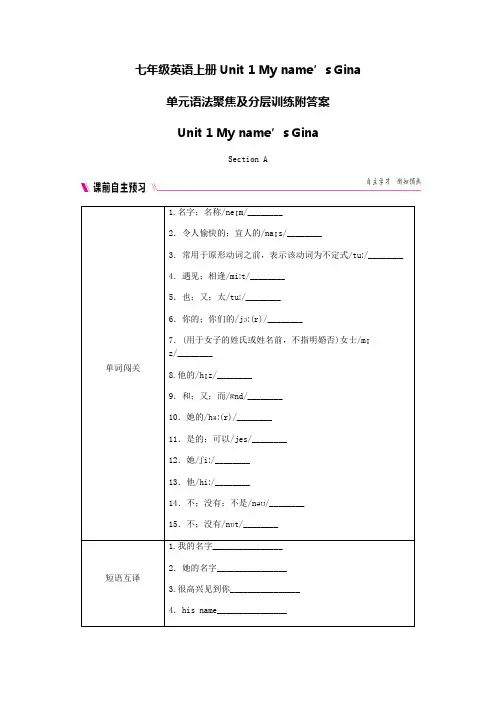
七年级英语上册Unit 1 My name’s Gina 单元语法聚焦及分层训练附答案Unit 1 My name’s GinaSection A.●1 name n. 名字;名称[拓展] (1)英语名字(如Helen Alva Smith)和汉语名字(如Chen Jiankang)的区别:(2)last name =family name ,意为“姓氏”;first name =given name ,意为“名字”。
英语姓名是名字在________,姓氏在________;汉语姓名是姓氏在______,名字在________。
活学活用1.—My name is Tony Baker.—So________ is your last name.A .Tony BakerB .BakerC .TonyD .Baker Tony●2 no adv. & adj.不;没有;不是not adv. 不;没有[观察] —Is this your book? 这是你的书吗?—No, it isn't.不,它不是。
Mr. Li is not a teacher. 李先生不是老师。
[探究] (1)no意为“不;没有;不是”,与yes相对,对问题、提议或请求等表示否定或拒绝,可单独使用。
(2)not作副词,意为“不;没有”,一般不单独使用,常位于be动词、助动词或情态动词之________,一起构成否定形式。
活学活用2.用no或not填空(1)I'm________ Lily. My name is Lucy.(2)—Are you Andy?—________, I'm___________.●1 What's your/his/her name?你的/他的/她的名字是什么?[探究] 该句是由疑问词what引导的特殊疑问句,用于询问某人的姓名。
其答语有三种形式:(1)My/His/Her name is+名字.;(2)I'm/He's/She's+名字.;(3)直接用姓名作答。
人教版新目标七年级英语上册第一单元Unit1My name's Gina单元大归纳
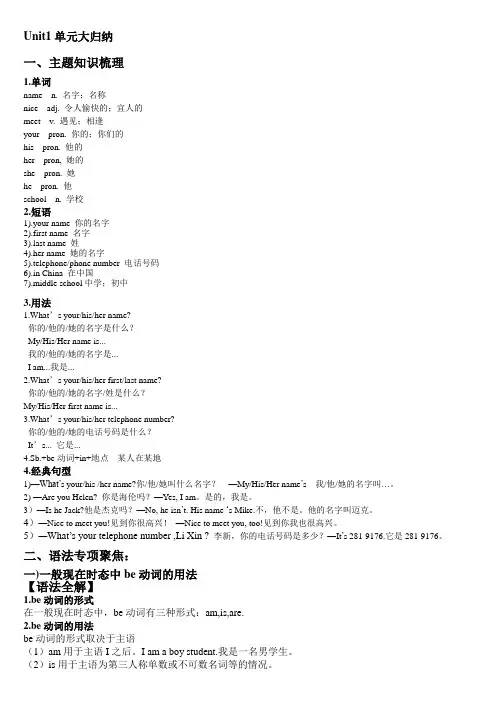
Unit1单元大归纳一、主题知识梳理1.单词name n. 名字;名称nice adj. 令人愉快的;宜人的meet v. 遇见;相逢your pron. 你的;你们的his pron. 他的her pron, 她的she pron. 她he pron. 他school n. 学校2.短语1).your name 你的名字2).first name 名字3).last name 姓4).her name 她的名字5).telephone/phone number 电话号码6).in China 在中国7).middle school中学;初中3.用法1.What’s your/his/her name?你的/他的/她的名字是什么?My/His/Her name is...我的/他的/她的名字是...I am...我是...2.What’s your/his/her first/last name?你的/他的/她的名字/姓是什么?My/His/Her first name is...3.What’s your/his/her telephone number?你的/他的/她的电话号码是什么?It’s... 它是...4.Sb.+be动词+in+地点某人在某地4.经典句型1)—What’s your/his /her name?你/他/她叫什么名字?—My/His/Her name’s 我/他/她的名字叫…。
2) —Are you Helen? 你是海伦吗?—Yes, I am。
是的,我是。
3)—Is he Jack?他是杰克吗?—No, he isn’t. His name ‘s Mike.不,他不是。
他的名字叫迈克。
4)—Nice to meet you!见到你很高兴!—Nice to meet you, too!见到你我也很高兴。
5)—What’s your telephone number ,Li Xin ?李新,你的电话号码是多少?—It’s 281-9176.它是281-9176。
人教版新目标英语七年级上册全册教案
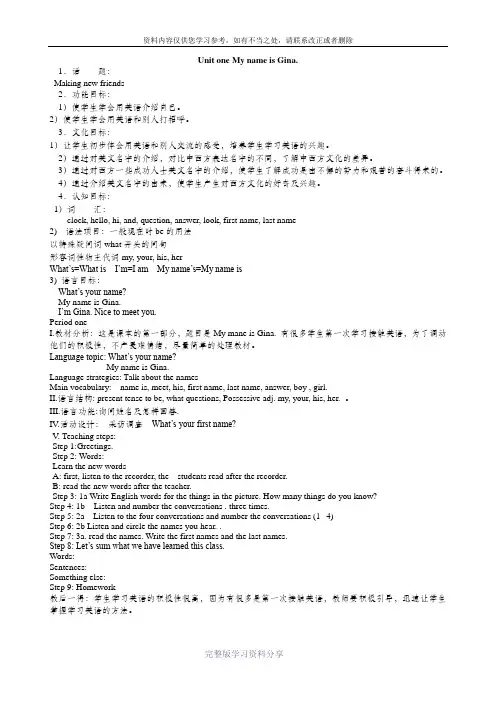
Unit one My name is Gina.1.话题:Making new friends2.功能目标:1)使学生学会用英语介绍自己。
2)使学生学会用英语和别人打招呼。
3.文化目标:1)让学生初步体会用英语和别人交流的感受,培养学生学习英语的兴趣。
2)通过对英文名字的介绍,对比中西方表达名字的不同,了解中西方文化的差异。
3)通过对西方一些成功人士英文名字的介绍,使学生了解成功是由不懈的努力和艰苦的奋斗得来的。
4)通过介绍英文名字的由来,使学生产生对西方文化的好奇及兴趣。
4.认知目标:1)词汇:clock, hello, hi, and, question, answer, look, first name, last name2) 语法项目:一般现在时be的用法以特殊疑问词what开头的问句形容词性物主代词my, your, his, herWhat’s=What is I’m=I am My name’s=My name is3) 语言目标:What’s your name?My name is Gina.I’m Gina. Nice to meet you.Period oneI.教材分析:这是课本的第一部分,题目是My mane is Gina. 有很多学生第一次学习接触英语,为了调动他们的积极性,不产畏难情绪,尽量简单的处理教材。
Language topic: What’s your name?My name is Gina.Language strategies: Talk about the namesMain vocabulary: name is, meet, his, first name, last name, answer, boy , girl.II.语言结构: present tense to be, what questions, Possessive adj. my, your, his, her. 。
初一英语上册(人教新目标)Unit 1 My name's Gina 知识点总结
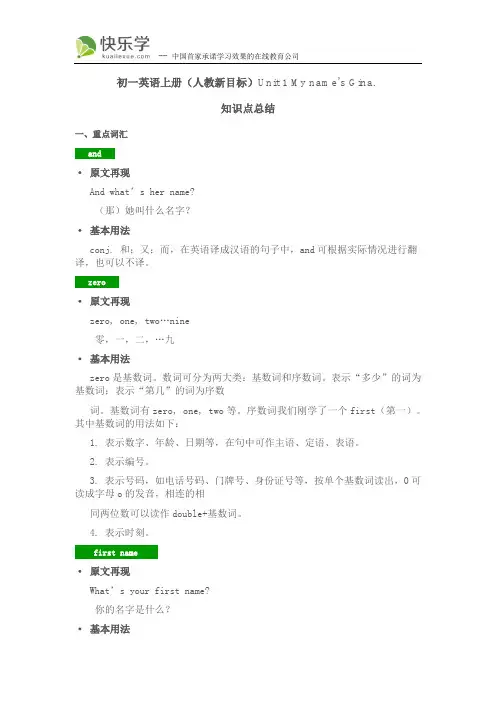
初一英语上册(人教新目标)Unit 1 My name's Gina.知识点总结一、重点词汇and· 原文再现And what’s her name?(那)她叫什么名字?· 基本用法conj. 和;又;而,在英语译成汉语的句子中,and可根据实际情况进行翻译,也可以不译。
zero· 原文再现zero, one, two…nine零,一,二,…九· 基本用法zero是基数词。
数词可分为两大类:基数词和序数词。
表示“多少”的词为基数词;表示“第几”的词为序数词。
基数词有zero, one, two等。
序数词我们刚学了一个first(第一)。
其中基数词的用法如下:1. 表示数字、年龄、日期等,在句中可作主语、定语、表语。
2. 表示编号。
3. 表示号码,如电话号码、门牌号、身份证号等,按单个基数词读出,0可读成字母o的发音,相连的相同两位数可以读作double+基数词。
4. 表示时刻。
first name· 原文再现What’s your first name?你的名字是什么?· 基本用法first name 意为“名”,也可以用given name表示。
I’m Kate Green. My first name is Kate.last name· 原文再现What’s your last name?你的姓氏是什么?· 基本用法last name意为“姓”,也可以用family name表示。
China· 原文再现My friend is in China.我的朋友在中国。
· 基本用法n. 中国,in China在中国。
· 知识拓展---相关单词n. Chinese 汉语;中文;中国人adj. Chinese 中国的;中国人的;汉语的We are Chinese.我们是中国人。
Tom can speak a little Chinese.汤姆会说一点儿汉语。
人教版七年级英语上教案英文全册
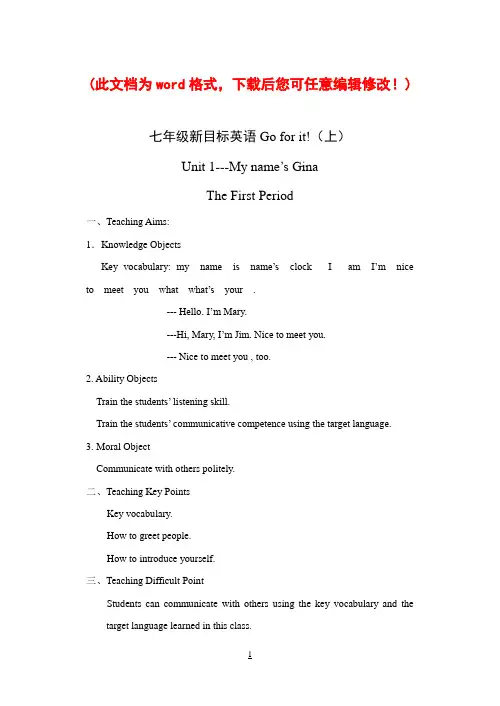
(此文档为word格式,下载后您可任意编辑修改!)七年级新目标英语Go for it!(上)Unit 1---My name’s GinaThe First Period一、Teaching Aims:1.Knowledge ObjectsKey vocabulary: my name is name’s clock I am I’m nice to meet you what what’s your .--- H ello. I’m Mary.---Hi, Mary, I’m Jim. Nice to meet you.--- Nice to meet you , too.2. Ability ObjectsTrain the students’ listening skill.Train the students’ communicative competence using the target language.3. Moral ObjectCommunicate with others politely.二、Teaching Key PointsKey vocabulary.How to greet people.How to introduce yourself.三、Teaching Difficult PointStudents can communicate with others using the key vocabulary and the target language learned in this class.四、Writing DesignUnit 1 ---- Lesson11.---What’s your name? --- My name is Alan..2.---Hello, I’m Mary. --- Hi, Mary, I’m Jim.3.--- My name is Jenny. --- I’m Gina. Nice to meey you!--- Nice to meet you, too.五、Teaching ProceduresStep1 RevisionLet the students sing the ABC song.Step2 Warming upHold up a book and ask:What’s this in English?Let them say: It’s a book..Show more things in this way, like ―key, lock, clock, ball ……‖Let the students turn to Page1 , 1a, look at the picture on the right carefully, Write down the words in the blank lines next to the picture..Suggested answers:Clock ball1.Show the students some new words on the paper:Jenny Gina Alan Mary JimMake them read the words for times.Let one student stand and answer:--- What’s your name?--- My name is Jenny.In this way, let the students ask and answer in pairs:---what’s your name?--- My name is Gina\ Alan \Mary\ Jim\ Alice\ Frank\ Dale\ Cindy\ Bob\ Helen\ Eric……2.Teach them and number the conversations.Then check the answers (213)Let the students read it loudly after the tape for several times.Step 5 Pair workAsk the students to practise the conversations with names.Give them someTarget language: ---What’s your\ .3. Moral Object :Team work is very important二.Teaching key pointsKey vocabularies.Listen and ask for special information.三、Teaching Difficult PointsPossessive adjectives: my, your,Unit 1----Lesson 2---What’s your name? my\ your\--- Her name is …五、Teaching ProceduresStep 1 RevisionAsk: --- What’s your name?Answer:--- My name is Jenny.\……--- Hello, Jenny. Nice to meet you.--- Hi, Mary. Nice to meet you, too.Let them ask and answer in pairs.Step 2 PresentationPoint to a boy student and say: His name is Tony\ Tom\ Bob\ Mike…Point to a girl student and say: Her name is Jenny\ Alice\ Cindy\ Grace……Point to as many students as possible, let the students say:His name is …Her name is … as quickly as possible. In this way, students can tell the difference between English names)---What’s English names)Let them ask and answer in pairs.Step 4 IntroductionTry to introduce your partner like this:My name is…… . His name is ……. Her name is ……Step5 HomeworkStep by step ---Exercise 2The Third Period一、Teaching Aims1. Knowledge ObjectsKey vocabulary: first, last, given, family, full, boy, girl, ID cardTarget language:What’s your first\ last\ given\ family \full name?2. Ability ObjectsCommunicative competence.Making a list of first names and last names of your classmates.3. Moral ObjectIt is a great who is learning a foreign language to know some culture about the country, because the language is closely associated with it.二.Teaching Key PointsKey vocabulary: first name, last name, given name, family name, fullnameTarget language: ask for and give first name, last name and familyname三、Teaching Difficult PointsMake a list of first name ,last name, given name and family name ofyou classmates.Tell the differences between Chinese names and Englilsh names.四、Writing DesignUnit 1---Lesson31、The differences between Chinese name and English name:Chinese name English nameYe Jintao John KingFirst name Last name First name Last nameFamily name Given name Given name Family name2. ---What’s your first\ last\ given\ family\full name?--- It’s ……五.Teaching ProceduresStep1. RevisionLet a pair stand and ask another pair next to them like this:---What’sPoint to one student and say: His name is Ye Jintao. That means name is Jintao. His family name is Ye,. And name is Sally. Her family name is King. Her full name is Sally King.Then point out that they’re many differences between the Chinese names and English names.List the differences between then on the blackboard.Step 3 PracitceAsk: --- What’s your \full\ first\ last\ given\ family\ name?Answer : --- It’s ……Ask: ---What’s your English\ Chinese name?Answer: --- It’s ……Step 4 Pair workLet them ask and answer the questions in pairs.Later, show them an ID Card and say:This is an ID Card, what’s \ family name?--- It’s ……Let them make an ID Card with both English name and Chinesename.Then ask and answer in pairs.Step 5 HomeworkStep and step----Exercise 3The Fourth Period一、Teaching Aims1. Knowledge ObjectsKey vocabulary: cardinal numbers 0-9, telephone number, it, it’sTarget language: ---What’s your teleph one number?--- It’s.2. Ability ObjectsListening skill.Communicative competence.Writing skill.3. Moral ObjectsKeep touch with your classmates andUnit 1----Lesson 4----What’s your \his\ her telephone number? ---It’s.----- What’s your\his\ her mobile phone\cellphone number? ---It’s.----What’s your\ his\ her ID Card number? --- It’s ……五.Teaching ProceduresStep 1 RevisionLet the students practice the following questions in pairs.--- What’s your first \last\ given \family \ full name?--- It’s ……--- What’s \ family\ full name?--- It’s ……Step 2 PresentationAsk: What’s your telephone\ phone number?Present them to say:Zero, one, two, three, four, five, six, seven, eight, nineLet the students read the words freely.Give them some and repeatListen to the tape and write down the telephone numbers. Complete 1b.Listen again and check the anawers . Complete 2a.Step 4. PracticeAsk four classmates for their phone numbers and fill in the address book in 2c.They can ask like this: ---What’s your telephone number?---It’s ……Step 5 WritingIntroduce two classmates in the cards below.Her\His first name is _________.A pictureHer\His last name is _______Her\His telephone number is _______Step 6 HomeworkStep by step--- ExerciseUnit 2 Is this your pencil?Period One (Section A 1a,1b. Selfcheck1,2)Teaching aims:1. pencil, pen, book, eraser, ruler, dictionary, yes, no, not, pencil case, pencil sharpener;2.the use of this/that;3.初步掌握一般疑问句及肯定、否定回答;Important and difficult points:1.the method of teaching and learning the new words;2. 一般疑问句及肯定、否定回答Teaching procedures:Step1. Warming-up:T:Good morning. My name is …. What’s your name?S: Good morning. My name is ….T: Nice to meet you.S: Nice to meet you, too.Step2. PresentationShow and learn our school things.Revision:What’s this in English? It’s a/an (pen, pencil, book, ruler…)Show some things first and ask:Is this / that your…? Yes, it is./ No, it isn’t.―What’s this in English?‖―This is my/his/her…‖Step3. Practice (Section A--1a )Teach the new words: pen, pencil, pencil case, pencil sharpener backpack, eraser, ruler, dictionaryStep4.Word challengeShow the things as quickly as possible, have a competition between boys and girls. Get them to name the things they see.Step5. Listen, number them and readSection A -- 1bStep6. PracticeDo self-check 1.Step7 .Pair workPractise the conversations in 1b, then make own conversations.Step8. Group task: A gameGroup of four, find the owner. Each student puts one or two things on the desk, then ask questions one another. Using: Is this your/his/her…?Step9.Conclusion:Unit 4 Where’s my backpack?1.Teaching aims1)Aims of abilitySs may show their desire skillfully in the situation designed by teacher. From the functional item practice, Ss may apply them in the real communication. Improve their listening ability as well.2) Aims of skillSome nouns about furniture as table, bed, dresser, bookcase, sofa, chair, drawer, daily use things as plant, CD, alarm clock, video tape, hat; some prepositions of place on, in, under, behind etc; where questions to ask the location of objects.3)Aims of emotionsMake Ss have interest and the desire of learning English, and happy to participate in various English practice. Make Ss help each other in groups and cooperate actively with others to complete learning task. Help Ss set up long-range ideals.2.Important and difficult points1)Where questions to ask the position of objects and use the right prepositions to answer.2)Yes-No questions to ask the position.3)Use the prepositions to describe a room.3. Teaching procedures:Period 1 (Section A 1a~1c)•Language focus:Talk about where the things are•V ocabulary:where, where’s, bookcase, sofa, chair, bed, table, dresser, drawer,plant, in, on, under•Language Structure:Where is…? It’s on / in / under…Teaching procedures:Step1 PresentationShow Ss a picture of a room with many things in it, and ask them to talk about the picture.S1: I can see…S2: I can see…S3: …Revise some words such as backpack, pencil, computer game etc. At the same time present the new words: table, bed, sofa, dresser, bookcase, chair, drawer, plant. Help Ss read the new words correctly.Unit5 Do have a soccer ballPeriod Three Section B一.Teaching aims1. Words: interesting fun boring difficult relaxing watch TV2. Structure:Let’s ......Do you have......Volleyball is so difficult.二.The important and difficult points:1. Talking about the feeling of the activities.2. To use the new words.三.Teaching steps.Step 1:Greeting and reviewing1. T: Good morning ,class! It’s a fine day.I think everyone in our class wants to go out and play sports.So do I.I have some sports things .Can you guess what I have .S1:Do you have a basketball?T:Yes,I do.S2:Do you have a soccer ball?T:No,I don’t have one.S3:Do you have a tennis racket?T:Yes,I do. Let’s play tennis.S3:That sounds good .Let’s go.2. Ss do in pair ask and answer about the teacher like this:S1:Does our teacher have a basketball?S2:Yes,she does.S1:Does our teacher have a soccer ball?S2:No,she doesn’t.Step 2 . Presentation.T:I have a basketball .Because I like basketball .I think it’s interesting /fun.Do you like it?S1:Yes,I do.It’s interesting.T:But I don’t like soccer.I think it’s boring. Do you like it?S2:Yes,I do .I think it’s exciting.T:Yes,many boys like soccer because it’s exciting.What about volleyball?S3:I don’t like volleyball ,because can’t play volleyball.T:Yes,I think volleyball is too difficult, but many people like watching it on TV. It’s relaxing. Write the new words on the Bb and practice these new words.Step 3. Listening and imitating.1. T:Look at these picture in Section B 1a.Do you know the boy ?Let me tell you hisUnit 6 DO YOU LIKE BANANAS?Period 3 Section BAims:①Talking about food and three meals②Words: egg apple carrot chicken breakfast lunch dinner fruit vegetable③For breakfast / lunch / dinner, I like…/ He likes…Importance: For breakfast / lunch / dinner, I like…/ He likes…Difficulty: Countable nouns and uncountable nounsStep1: GreetingStep2: Presentation(Show slides)①Review words: banana hamburger tomato broccoli French fries orange ice cream salad strawberry pear②Teach new words: egg apple carrot chicken③通过归类teach(banana strawberry apple )fruit(tomato broccoli carrot)vegetable④Show slides ―My day‖ 呈现new words breakfast lunch dinnerAt 7:00 for breakfast , I like…,At 11:00 for lunch, I like…, At 18:00 for dinner, I like….Learn, read and remember the new words for a few minutes.Step 3: ①A memory game. Show a slide about many kinds of food. Let Ss have a quick look. Then ask them to say what they see in the picture.Step 4: ①do 1a quickly, check②do 1b in pairs, checkStep 5: PresentationT:(Show a slide.)Look. It’s tea .It’s a cup of tea.T: What’s this in English?Ss: It’s milk.T: Yes, it’s a box of milk. And what about these?Help Ss answer: They are two boxes of milk.T: Good! Do you like milk?…Present the following words in the same way:water/a bottle of water/ three bottles of waterorange juice / a bottle of orange juice / four bottles of orange juicerice / a bowl of rice / three bowls of ricebread / a piece of bread / some pieces of breadmeat / a plate of meatTell Ss these are all uncountable nouns.T:(Show a slide.)But what are these?Ss: They are apples / three apples.Unit7 How much are these pants?第1课时Section A (1a-1c)一、教学内容:1.Words and phrases:how much,pants,sock,shirt,T-Shirt,shorts,sweater,shoe,dollar.2.New patterns:How much is this T-shirt?It’s seven dollars.How mu ch are these socks?They’re seven dollars.二、教学目标:1.掌握新的服装类词汇和短语及其相关用法.2.能熟练运用数字准确表达价格和询问物品价格.三、教学重难点:1.熟练运用新学词汇和短语谈论衣服,询问价格。
人教新目标七年级英语上册正式篇Unit1教学设计
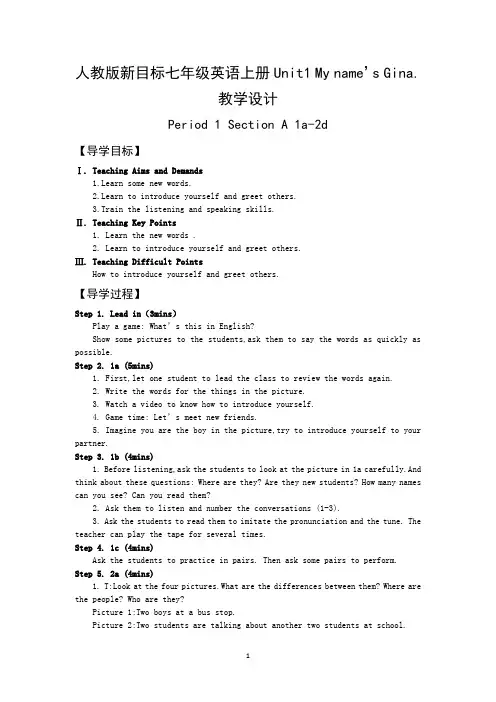
人教版新目标七年级英语上册Unit1 My name’s Gina.教学设计Period 1 Section A 1a-2d【导学目标】Ⅰ. Teaching Aims and Demands1.Learn some new words.2.Learn to introduce yourself and greet others.3.Train the listening and speaking skills.Ⅱ. Teaching Key Points1. Learn the new words .2. Learn to introduce yourself and greet others.Ⅲ. Teaching Difficult PointsHow to introduce yourself and greet others.【导学过程】Step 1. Lead in(3mins)Play a game: What’s this in English?Show some pictures to the students,ask them to say the words as quickly as possible.Step 2. 1a (5mins)1. First,let one student to lead the class to review the words again.2. Write the words for the things in the picture.3. Watch a video to know how to introduce yourself.4. Game time: Let’s meet new friends.5. Imagine you are the boy in the picture,try to introduce yourself to your partner.Step 3. 1b (4mins)1. Before listening,ask the students to look at the picture in 1a carefully.And think about these questions: Where are they? Are they new students? How many names can you see? Can you read them?2. Ask them to listen and number the conversations (1-3).3. Ask the students to read them to imitate the pronunciation and the tune. The teacher can play the tape for several times.Step 4. 1c (4mins)Ask the students to practice in pairs. Then ask some pairs to perform. Step 5. 2a (4mins)1. T:Look at the four pictures.What are the differences between them? Where are the people? Who are they?Picture 1:Two boys at a bus stop.Picture 2:Two students are talking about another two students at school.Picture 3:A boy and a girl in a school.Picture 4:A teacher and her students in class.2. Listen for the first time,get the main idea.3. Then listen and number the pictures (1-4).4. Ask one student to check the answers.And try to say the reason.Step 6. 2b (5mins)1. First,read the instruction in 2b.Let the students know this time they should listen for specific information--the names.2. Read the names.3. Then listen and circle the names they hear.Check the answers.4. Listen again,and try to answer these questions:(1) What are the two boys’ names in Picture 1? Are they Eric and Mike?(2) Is Alice in Picture 3?/What’s the girl’s name in Picture 3?(3) Is the boy’s name Eric?(4) Are the boy and girl in Picture 2 the same as the two children in Picture 3?(5) What’s the teacher’s name? How many students are there in her class? Step 7. 2c (6mins)1. Look at the pictures and practice the key sentences:What’s his/her name?His/Her name is ….2. Play a memory game.3. Recite the key sentences through a chant.4. Pair work:introduce yourself and your friend.Step 8. 2d (7mins)1. Listen to the tape and think about two question:How many people are there in the conversation? Who are they?2. Ask the students to read the conversation by themselves and then answer the questions.3. Follow the tape.Students read the conversation in roles. (They can change their roles.)4. Call some students to perform for the whole class.Step 9. Summary (2mins)Let the students summarize what they’ve learnt according to the clues. Step 10. Exercises (5mins)【探究归纳】1.What's your name? 你叫什么名字?(1)这是一个由what引导的特殊疑问句,是询问别人姓名的常用语,回答时常用“My name is….”或“I'm….”或者直接说出名字。
七年级英语上册Unit1《Myname’sGina》教案人教新目标版
Unit 1 My name is Gina.Language goals:In this unit students learn to introduce themselves, greet people and ask for andgive telephone number.New languages:What’s your name? My name is /I’m …Hello! I’m … /Hi! I’m …Nice to meet you!What’s his name? His name is …What’s her name? Her name is …What’s her family name?What’s her first name?What’s your phone number?Difficult points:1. How to introduce yourself and greet people in the right way.2. I mprove the students’ reading, listening, speaking a nd writing skills.3. The difference between Chinese names and English names. Teaching aids:computer, recorder, colorful chalkTeaching periods:Period 1: Section A 1a /1b /1c /2a /2b /2c/ Grammar FocusPeriod 2: Section A 3a /3b /4Period 3: Section B 1a /1b /2a /2b /2cPeriod 4: Section B 3a /3b /3c /4 / Self checkPeriod 1Teaching aims:1. Memorize the words on page1and page2.2. Learn the target languages:My name is Gina.What’s your name?Hello! I’m Mary.Hi! I’m Jim.What’s his name?What’s her name?3. Train the listening and speaking skills.Teaching procedure:Step 1 Free talkLet students talk in pairs using the sentences they’ve learned in Starter or ask some questions in Starter, have students answer them. For example: Good morning/afternoon/evening!How are you?What’s this in English?What color is it?Step 2 Section A 1aThis activity tests students’ vocabulary.1. Draw student’s attention to the pictures. Point to an object in it andask what it is. Say, now look at the pictures and write down as many words as you can2. Ask two students to write the words on the blackboard.3. Check the students’ answers. Ask some students to call out their wordsand spell them. Write down the words on the board.Step 3 Section A 1bThis activity gives students practice in understanding the target language in spoken conversation.Read the instruction to the students. Make sure the students understand how to do it. Say, now listen and number the conversations 1-3.(1) Play the recording for the first time. Students only listen.(2) Play the recording a second time. Students number the conversations.(3) Check the answers together.Step 4 Section A 1cThis activity provides guided oral practice using the target language.(1) Ask three pairs to read the conversations in 1b. If necessary, ask studentsto repeat the names after the teacher.(2) Have students work in pairs to practice the conversations.(3) Say, Now use your own names when you have conversations .Move around theroom monitoring their work. Offer language or pronunciation support asneeded.(4) Let several pairs come to the front of the class and act out theirconversations.Step 5 Section A 2aThis activity gives students practice in understanding the key words andtarget languages.1. Point to a boy and a girl. Say, His name is---, her name is--- Have studentsunderstand the meaning of his and her.2. Read the instruction to the students.3. Play the recording for the first time. Students only listen.4. Play the recording a second time. Students number the pictures 1-4.5. Check the answers.Step 6 Section A 2bThis activity provides listening practice.(1) Have one student read the names in the box.(2) Say, listen to the four conversations again.This time circle the names you hear.(3) Students listen and circle the names.(4) Check the answers.Step 7 Section A 2cThis activity provides guided oral practice using the target language.(1) Call attention to the two conversations in the box.Ask one pair to act out the first one. Tell them to use their own names.Ask another pair to act out the second one.Have them point to a boy or a girl when they ask the questions:What’s his name/What’s her name?(2) Let students work in pairs to practice the two conversations. As studentswork, move around the classroom, monitoring the conversations andoffering assistance if necessary.(3) Have several pairs of students present their conversations to the class. Step 8 Grammar Focus(1) Divide the class into two groups to say the questions and responses.(2) Write down the full forms and contractions of the words on the right.Have students compare them. Then ask them to say the sentences in two ways. Step 9 Conclusion(1) Learn the words and phrases.(2) Master the target languages:My name is Gina.What’s your name?Hello! I’m Mary.Hi! I’m Jim.What’s his name?What’s her name?Step 10 Homework(1) Learn the words by heart.(2) Practice the conversations in 1b and Grammar Focus.(3) Do some preparing.Period 2Teaching aims:1. Memorize the words and phrases: first, first name, last, last name, boy, girl2. Learn about first name and last name.3. Train writing and speaking skills.Teaching procedure:Step 1 Revision1. Go over the words in last class. (Play a game. Divide the class into twogroups: boys and girls. Give them three minutes to read and write the words.Then look at the Chinese meaning on the cards. See which group can say andspell the words more quickly and correctly. )2. Ask students to make conversations about introduction and greeting. Step 2 Section A 3aThis activity introduces the western concept of first name and last name.1. Write down a Chinese name and an English name on the board. For example:Deng Yaping and Jim Smith.2. Ask students to discuss the names. Encourage them to tell the differencebetween them. (English names are listed with the given name first and thefamily name or surname second. While Chinese names are listed with thefamily name first and given name second.)3. Ask some students to say their family names and first names.4. Have two students read the list of names in the box. Say, Guess, whichnames are first names and which are last names?5. Ask students to write F for first name and L for last name next to thewords. Students do the exercise by themselves.6. Check the answers.Step 3 Work in pairs(1) Call attention to the picture on the right. Students look at the pictureand the sentences carefully. Have them pay attention to what the teacherwrites.(2) Have two students read the conversations in the picture aloud.(3) Ask students to work in pairs.Ask and answer about their first names and last names.Step 4 Section A 3bThis activity provides guided oral practice using the target language.(1) Point to the names in 3a.( You can write more names on the board.)(2) Say, Which names would you like to choose as your first name and lastname? Now choose your names.(3) Have students take turns to ask and answer the questions (using theirnew names):What’s your first name?What’s your last name?Students make a list of names.Then exchange their lists to correct any mistake they make.Step 5 Section A 4 (Game)This activity gives students an opportunity to practice target language in an interesting way.1. Demonstrate the game with three students.2. Say, Now in groups of four, play the game. As they work, move around theclassroom making sure students understand the procedure and correcting anymistake.3. Ask two groups to present their games to the class.Step 6 Conclusion(1) Learn the words and phrases in this class.(2) Grasp the target languages:What’s your first name?What’s your last name?Step 7 Homework(1) Memorize the words and phrases.(2) Make a conversation about asking for first name and last name.(3) Prepare next lesson.Period 3Teaching aims:1. Memorize the words on page4.2. Target languages:What’s your phone number?It’s …3. Train the listening and speaking skills.Teaching procedure:Step 1 Free talkLet students work in pairs. Make conversations using the target languages they’ve learned. For example:What’s your name? My name is …What’s his name? His name is …What’s her name? Her name is …What’s your first name?What’s your last name?Step 2 Section B 1aThis activity learns the numbers from 0 to nine.(1) Write the numbers 0-9 on the board. Ask who can say them in English.Encourage more students to read them.(2) Play the recording for the first time. Students only listen.(3) Play the recording a second time. Have students repeat the numbers.(4) Give students two or three minutes to read and write the mummers. Thenhave some students say them quickly and ask if anybody can spell them.Cheer for the students who do best.Step 3 Section B 1bThis activity gives students practice recognizing the numbers 0-9 in spoken telephone numbers.Say, Now listen to the conversation, and write down the telephone number you hear.(1) Play the recording for the first time. Students only listen.(2) Play the recording a second time.Have students write the numbers in the blank.(3) Check the answers.(4) Work in pairs and practice the conversation.Step 4 Section B 1cThis activity gives students speaking practice using the target language.(1) Call attention to the conversation on the right. Have two students read it.(2) Practice the conversation in pairs.(3) Say,Now in groups of three or four, make up conversations using any phonenumber you like .As they work, move around the room monitoring their work.Offer language or pronunciation support as needed.(4) Let several pairs come to the front of the class to perform theirconversations for the class.Step 5 Section B 2aThis activity provides listening practice with the target language.1. Call attention to the names and the numbers in the box.2. Read each one to the class or ask some students to read them.3. Point to the blanks in the four telephone numbers. Say, The phone numbersaren’t finished. You need to write the last two numbers later. Now listenand match the names with the telephone numbers.4. Play the recording for the first time. Students only listen.5. Play the recording a second time Students write the letter of the person’stelephone number in the space after that person’s name.6. Check the answers.Step 6 Section B 2bThis activity gives students practice recognizing the spoken numbers 0-9.(1) Say, Now let’s listen to the conversations again and finish each telephonenumber.(2) Students listen and fill in the missing numbers.(3) Check the answers.(4) If have time, have students repeat the telephone number after the recording.(5) Practice the four conversations in pairs.Step 7 Section B 2cThis activity provides guided oral practice using the target language.(1) Call attention to the address book. Ask one student,“What’s your phone number?” Write his/her name and phone number inthe address book.Make sure all the students understand how to fill in the address book.(2) Say, Now ask your four classmates their phone numbers and fill in theform.Step 8 Conclusion(1) Learn the numbers 0-9.(2) How to asking for phone number:What’s your phone number?It’s …Step 9 Homework(1) Remember the numbers from 0 to 9.(2) Make two conversations.(3) Do some preparing.Period 4Teaching aims:1. Memorize the words and phrases on page2. How to ask for first names/last names/phone numbers.3. Train speaking and writing skills.Teaching procedure:Step 1 Revision1. Go over the numbers in last class.Ask the students to read and spell numbers from 0-9.2. Talk about phone numbers.Step 2 Section B 3aThis activity reviews about first name and last name.1. Say, Look at the picture. How many cards can you see?Can you read the names on the card?2. Ask four students to read the names on each card. Then say,“Which is first name and which is last name? Do you know?”3. Point out the blank line following each first name in the exercise.Say, Write each person’s last name in the blank after the first name.4. Students finish the exercise individually.5. Check the answers.Step 3 Section B 3b & 3cThis activity provides speaking and writing practice using the target language.(1) Point to the ID card. Say, Look at the girl on the card. What’s hertelephone number? What’s her family name? What’s her first name?(2) Have students work in pairs and answer the three questions.(3) Check the answers.(4) Say, Look at the ID card in 3c. This is your card. Write your own firstname, last name, and telephone number on it.(5) As students work, move around the room checking progress.Step 4 Section B 4This activity gives students an opportunity to practice target language ina game.Read the instruction to the class. Make sure all the students know how to do it. Move around the room monitoring their work. Offer language or pronunciation support as needed.。
人教版初一英语教案
人教版初一英语教案【篇一:人教版七年级上册英语全册教案】新目标英语(go for it)七年级上全册教案unit 1-12unit 1 my name’s ginaperiod one课前准备教师:准备游戏时所用的图片(食物、蔬菜、动物)。
学生:准备表演时所需道具(服装、假发)。
教学设计step one :present the sentence patterns.1. play a game “how many words do you know?”(利用小游戏调动学生的积极性,同时通过对冠军的介绍引出本课。
)teacher: after the study of the first three starters, i thinkmost of the students must have known a lot of words. how manywords do you know? let’s play a game to see who know? let’s play a game to see who knows the most.(divide all the students into several groups and show a picture (图片略) to them with the computer. every group can choose two students to join. they are asked to come to the blackboard and write down the words in 30 seconds.)(group 2 is the champion group. they can write 11 words.)2. introduce the champion group to the class.(引课方式贴近生活,学生易于接受)teacher: congratulations, now group 2 is the champion. but i don’t know your names. would you like to introduce y ourselves to us?s1 s2:yes.s1:hello.my name is li lei. nice to meet you.ss: hello, li lei. nice to meet you ,too.ss: hello! what’s your name?s2:i’m sun ping. how do you do?ss: how do you do ?step two: drills.1. make introductions.(通过句型的操练使学生更加熟练掌握所学的句式。
人教版英语七年级上册教案:StarterUnit1Period2(2a-2e)
Ssworkintheirseastentothetapeandseeifyoudowell.
4评价 学生 的学 习
Step 4
Post-liste ning
1)writing
1. T: Now let's learn how to write these letters. First look at the picture carefully in 2c. Then tell us how to write these English letters.
【课型】Listening and Letters writing(字母书写课)【本课时教学设计】
教材版本:人教版 册数:七年级上册 年级:七年级 单元:预备一单元课型(课时):字母书写课
教材分析
【本单元话题】本单元将字母学习和英语的问候及应答话题学习相结合循序渐进地呈现了英语问候语的表达法,并通过听说活
教学重难点
1.教学重点:
1)学习掌握字母Aa~Hh的字母顺序,读音及书写。
2.教学难点:
1)学习掌握字母Aa~Hh的字母顺序,读音及书写。
建议教法
情景交际法,任务型教学法,听说课的“3P”教学模式:
P--呈现(语言输入)
P--操练( 1.机械操练2.听力训练)
P--运用(语言输出)
设置情景意义操练
设计听后活动任务,先模仿再迁移
动让学生巩固、运用。
【本单元重点掌握目标】在问候时 ,自然地介绍了 8个常见的英语名字。侧重字母的学习 ,要求学生能正确认读和规范书写字母Aa—Hh,并掌握这8个字母的顺序 ,同时 ,结合本单元的字母和单词 ,了解元音字母A和E在开音节和闭音节中的常见发音。最后的一个歌谣 ,帮助学生巩固本单元的目标语言。
七年级英语上册Unit1Myname’sGina教案人教新目标版(2021年整理)
七年级英语上册Unit 1 My name’s Gina教案(新版)人教新目标版编辑整理:尊敬的读者朋友们:这里是精品文档编辑中心,本文档内容是由我和我的同事精心编辑整理后发布的,发布之前我们对文中内容进行仔细校对,但是难免会有疏漏的地方,但是任然希望(七年级英语上册Unit 1 My name’s Gina教案(新版)人教新目标版)的内容能够给您的工作和学习带来便利。
同时也真诚的希望收到您的建议和反馈,这将是我们进步的源泉,前进的动力。
本文可编辑可修改,如果觉得对您有帮助请收藏以便随时查阅,最后祝您生活愉快业绩进步,以下为七年级英语上册Unit 1 My name’s Gina教案(新版)人教新目标版的全部内容。
Unit 1 My name’s Gina.The First PeriodSection A (1a—2d)Ⅰ.Teaching aims:1.Knowledge aims:(1)Key words:name,nice,to,meet,too,your,Ms.,his,and,her,yes,she,he,no,not(2)Key phrases:Nice to meet you.(3)Important sentences:①—What’s your/his/her name?—My/His/Her name is .。
②—Nice to meet you.—Nice to meet you,too.2.Ability aims:Introduce yourself and greet people。
3.Emotion aims:Improve students’ conversation skills。
II.Important points:The usage of pronouns。
III。
Difficult points:Grasp the usage of pronouns.IV。
- 1、下载文档前请自行甄别文档内容的完整性,平台不提供额外的编辑、内容补充、找答案等附加服务。
- 2、"仅部分预览"的文档,不可在线预览部分如存在完整性等问题,可反馈申请退款(可完整预览的文档不适用该条件!)。
- 3、如文档侵犯您的权益,请联系客服反馈,我们会尽快为您处理(人工客服工作时间:9:00-18:30)。
his ruler. 4. Jim is here. This is ____
her watch. 5. That is Amy. And this is _____
1
2
3
4
5
6
2b
Tony Bob
Listen again. Circle the names you hear. 再听一遍。圈出你听到的名字。Tom MikeJeny Jim我是小小表演家
原创新课堂第七页第二大题
Thank you!
Goodbye!
2a
3
Listen to the conversations and number the pictures[1—4].听四段对话,给下列 图片编号[1—4]。
his
her your my
他的
她的 你的 我的
口诀:
男他的his,
女她的her,
your是你的,
my是我的,
名词前面常站岗, 限定所属有功劳。
A: What‟s your name? B: My name is Dinah.
your name 你的名字 my name 我的名字
A: What‟s her name? B: Her name is Gina.
1
2
4
Fill in the blanks with „ my, your , his , her.”
1.I am a Chinese girl. My ____ name is LI Ying. yourjacket? --- yes, it is. 2. – Tom, is this _____ 3. – Is this your backpack? – No, it isn‟t . It‟s his/her _________ backpack.
Unit 1
My name‟s Gina.
Period two
Jenny
Gina
Alan
Mary
Jim
Tony
Linda
在一个社区里面住着一对邻居,一户人家很 有钱,他们有一个很自以为是的女儿,总喜欢呵 呵的笑,所以她的名字叫“呵”(her)。另一 户人家很穷,他们有一个儿子很黑,所以他的名 字叫“黑子”(his)。 有一天,呵(her)在逛街的时候碰到黑子 (his)在卖易拉罐,她马上走过去嘲笑黑子 (his):“呦(your),这些垃圾是你的呀?” 黑子 (his)不卑不亢地说:“我卖(my)我的劳动成果 有什么丢脸的吗?”呵(her)听了之后,脸红地走 开了。
her name 她的名字
A: What‟s his name? B: His name is Alan.
his name
他的名字
his her name? What‟s _____
_____ His Her name is Zhao Zhao Benshan Wei .
A :What’s his / her name ? B :His / Her name is …
